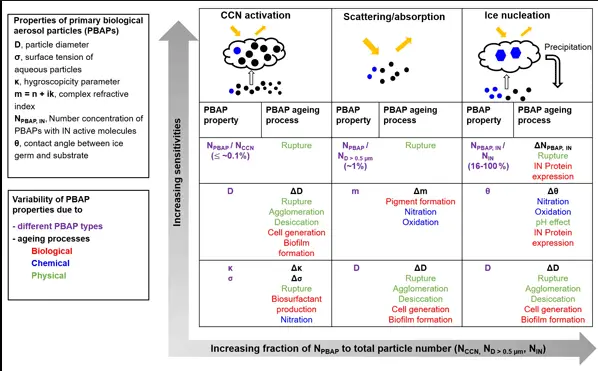Aerosols and particulate matter are two critical components of the atmosphere, both playing pivotal roles yet distinctly different from each other. Aerosols refer to a mixture of fine solid particles or liquid droplets in air, whereas particulate matter specifically denotes the solid and liquid particles suspended in the air that are of concern due to their effects on human health and the environment. Their study is crucial for environmental science, public health, and climate policy.
The key difference between aerosol and particulate matter lies in their definition and scope. Aerosols encompass a broader range of particles in the air, including dust, mist, and smoke, and are not restricted by particle size. In contrast, particulate matter is defined by specific size thresholds which determine their potential to cause health problems and environmental impact. This difference affects how they interact with the environment and human health.
Both aerosol and particulate matter significantly affect air quality, with varying implications for climate patterns and public health. While both contribute to atmospheric haze and impact global climate, their management and measurement techniques remain complex due to their diverse sources and compositions. Understanding their distinctions not only aids in scientific research but also helps in devising more effective environmental regulations and health advisories.

Definitions
What is Aerosol?
An aerosol is a suspension of fine solid particles or liquid droplets in air or another gas. These particles may be of natural origin, such as fog, forest exudates, and geyser steam, or they can originate from human activities, such as smoke from fires and emissions from industrial processes. Aerosols vary in size but are typically small enough to remain aloft in the atmosphere for extended periods of time.
What is Particulate Matter?
Particulate matter (PM) refers specifically to the mixture of solid particles and liquid droplets found in the air. Unlike aerosols, particulate matter is often categorized by size, with PM10 and PM2.5 being the most commonly monitored. PM10 includes particles with a diameter of 10 micrometers or smaller, and PM2.5 includes particles with a diameter of 2.5 micrometers or smaller. These particles can be made up of a variety of components including acids (such as nitrates and sulfates), organic chemicals, metals, soil or dust particles, and allergens (such as pollen or mold spores).
Composition and Sources
Aerosol Composition
The composition of aerosols can vary widely depending on their source. Natural aerosols may consist of sea salt from ocean spray, fine soil from winds, and sulfates produced by volcanic activity. Anthropogenic (human-caused) aerosols often contain carbonaceous compounds from combustion processes, metals from industrial emissions, and chemicals from aerosol sprays.
Particulate Matter Composition
Particulate matter is typically composed of substances like black carbon, organic chemicals, metals, and dust. The finer PM2.5 particles tend to contain more toxic organic compounds and heavy metals because they arise from combustion sources, including motor vehicles, power plants, and residential wood burning.
Common Sources for Both
Both aerosol and particulate matter share common sources such as:
- Industrial activities: Emissions from factories and power plants release a significant amount of particulates into the atmosphere.
- Automobiles and transportation: Gasoline and diesel engines emit both aerosols and particulate matter.
- Natural sources: Wildfires, volcanic eruptions, and dust storms contribute naturally to both aerosols and particulate matter in the air.
Physical Properties
Size Distribution
The size distribution of aerosols and particulate matter is crucial in determining their behavior and fate in the atmosphere. Aerosols can range from a few nanometers to about 10 micrometers in diameter. In contrast, particulate matter is often classified into coarse (PM10) and fine (PM2.5) categories based on their diameter, affecting everything from how deep they can penetrate into the lungs to their residence time in the atmosphere.
Chemical Characteristics
The chemical characteristics of aerosols and particulate matter affect their optical properties, reactivity, and health impact. Aerosols can be composed of organic compounds, inorganic compounds, or a mix of both, often leading to complex reactions in the atmosphere with gases and other particles. Particulate matter often contains heavy metals like lead and arsenic, organic compounds from combustion, and secondary inorganics formed by atmospheric reactions.
Environmental Impact
Effects on Air Quality
Both aerosols and particulate matter have profound effects on air quality. High concentrations can reduce visibility and contribute to the formation of urban smog. Particularly, PM2.5 is known to penetrate indoors, affecting indoor air quality. Their presence in the air can exacerbate respiratory and cardiovascular diseases among the exposed population.
Climate Influence
The impact of aerosols and particulate matter on the climate varies widely. Aerosols can cool the Earth’s surface by reflecting sunlight back into space (albedo effect) or warm it by absorbing heat. Similarly, particulate matter can influence cloud formation and precipitation patterns, thereby altering the climate. The complex interactions between aerosols, particulate matter, and climate factors make this a critical area of ongoing research in environmental science.
Health Implications
Aerosol Exposure Risks
Exposure to aerosols can pose significant health risks, particularly when the particles are small enough to be inhaled deeply into the lungs. Some key health concerns include:
- Respiratory issues: Inhalation of aerosols can lead to diseases such as asthma, bronchitis, and other respiratory infections.
- Cardiovascular problems: Fine particles can enter the bloodstream, leading to cardiovascular diseases including heart attacks and strokes.
- Allergic reactions: Natural and anthropogenic aerosols can carry allergens that trigger allergic reactions and other health complications.
Particulate Matter and Health
The health impacts of particulate matter are well-documented and particularly severe. PM2.5, due to its ability to penetrate deep into the lung tissue, is especially dangerous:
- Chronic respiratory diseases: Continuous exposure to PM2.5 is linked with the development of chronic obstructive pulmonary disease (COPD) and reduced lung function.
- Increased mortality: Studies have shown a correlation between elevated levels of fine particulate matter and increased mortality rates due to cardiovascular and respiratory diseases.
- Cancer: Long-term exposure to particulate matter has been linked to an increased risk of certain types of cancer, particularly lung cancer.
Measurement Techniques
Monitoring Aerosol Levels
Effective monitoring of aerosol levels is crucial for assessing environmental quality and health risks. Techniques include:
- Satellite observations: These provide comprehensive coverage and monitoring of aerosol dispersion on a global scale.
- Ground-based stations: These measure local aerosol concentrations, providing data crucial for urban air quality management.
- Lidar systems: Light Detection and Ranging (Lidar) is used for measuring aerosol profiles and properties over time to assess their impact on climate and health.
Detecting Particulate Matter
Detecting particulate matter involves various technologies, each suited to different particulate sizes and concentrations:
- Filter-based sampling: This method captures particles on filters for later analysis in a lab.
- Optical sensors: These detect particles based on how they scatter light, providing real-time data on PM levels.
- Beta attenuation monitoring: This technique measures the mass of particulate matter by detecting the reduction in beta radiation passing through an air sample.
Regulation and Control
Global Standards for Aerosols
The global standards for aerosols aim to reduce health risks by controlling emissions from various sources. These standards include:
- Limits on emissions: Regulatory bodies set maximum allowable emissions for industries known to release significant aerosols.
- Product safety regulations: Aerosol products, such as sprays and inhalants, must meet safety criteria to minimize indoor air quality impacts.
- International agreements: Agreements like the Montreal Protocol regulate substances that lead to aerosol formation, protecting both health and the environment.
Particulate Matter Guidelines
Particulate matter guidelines are established by organizations like the World Health Organization (WHO) to guide policy and protect public health. These guidelines suggest maximum exposure limits to different sizes of particulate matter, emphasizing the need for continuous monitoring and control.
Current Research
Innovations in Measurement
Recent advances in the measurement of aerosols and particulate matter focus on enhancing accuracy and real-time data availability. Innovations include:
- Portable monitoring devices: These allow for personal exposure assessment in real-time, providing data that can help individuals avoid high-pollution areas.
- Drone technology: Drones equipped with sensors are being used to assess particle distribution and composition in various layers of the atmosphere.
- Machine learning models: These are increasingly used to predict air quality levels based on historical data and real-time inputs from monitoring stations.
Future Directions in Regulation
Future regulatory directions aim to better integrate scientific findings into public health policy and environmental management:
- Stricter standards: As evidence mounts about the dangers of even low levels of particulate matter, regulations are expected to become stricter.
- Localized approaches: Understanding that air pollution can vary dramatically by location, future regulations may focus more on localized strategies to combat air quality issues.
- Public engagement: Increasing public awareness and involvement in monitoring and reporting air quality issues is seen as a crucial component of effective environmental management.
Frequently Asked Questions
What defines an aerosol?
Aerosols are tiny particles or droplets suspended in the atmosphere. They can originate from natural sources like dust storms and sea sprays, or from human activities such as burning fossil fuels and industrial processes. Their size can vary, which influences how long they stay in the atmosphere and how far they can travel.
How does particulate matter affect health?
Particulate matter, especially fine particles like PM2.5 (particles smaller than 2.5 micrometers), can penetrate deep into the lung tissue and even enter the bloodstream, causing cardiovascular, respiratory, and other health issues. Long-term exposure is linked to increases in the incidence of chronic diseases such as asthma, heart disease, and lung cancer.
Are aerosols visible?
While individual aerosol particles are usually microscopic and not visible to the naked eye, they can collectively influence visibility. For example, when aerosols accumulate in high concentrations, they can cause visible haze, affecting the clarity and color of the sky.
What is PM10?
PM10 refers to particulate matter that is 10 micrometers or smaller in diameter. These particles include dust, pollen, and mold. PM10 particles are small enough to be inhaled and can cause adverse health effects, particularly in the respiratory system.
Conclusion
Understanding the difference between aerosol and particulate matter is crucial for environmental and health sciences. Each has unique characteristics that influence their role in air quality and climate change. The distinctions between them highlight the need for targeted environmental policies and health guidelines to mitigate their effects.
This comprehension is not just academic; it has practical implications for public health policies and environmental management strategies. By recognizing and addressing the specific challenges posed by aerosols and particulate matter, policymakers can better protect human health and manage the environmental impacts associated with air pollution.

